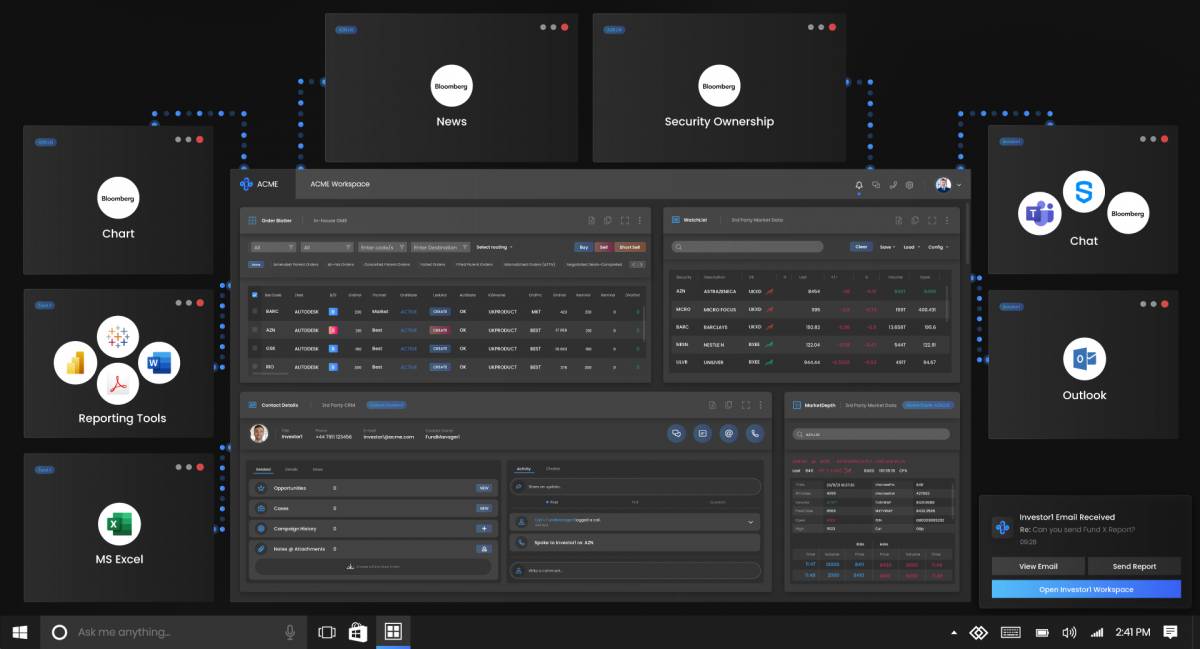By Reena Raichura, Director, Head of Product Solutions at Glue42.

The very nature of a hedge fund is to maximize investor returns while mitigating risk through systematic trading. Bleeding edge technology, speed, and data are the lifeblood for systematic traders, yet the focus has traditionally been on developing and enhancing the back end of the technology stack with the front-end often getting left behind.
Trading desktops at hedge funds, like other trading desktops in capital markets remain fragmented and often monolithic in nature.
Hedge fund managers don’t just work in one application, they work across many applications such as an OEMS, Position and Risk, Market Data Terminals, Analytics, Chat, Excel, BI Tools and more to get their jobs done. None of these applications communicate with each other at the desktop level and therefore, hedge fund managers have been confined to data and workflows within the walls of single applications, yet their job requires them to access data and work across multiple applications. As a result, they have had to work around the applications to get what they need in a cumbersome ‘swivel-chair’ fashion by re-keying data and copying and pasting, often missing key information needed to attract investors and make better execution decisions.
What if you could use today’s technology to break through the walls of these applications to streamline workflows, improve efficiency and be more effective both with investors and in the market to increase profitability?
Step in desktop integration platforms…
What is a Desktop Integration Platform?
A desktop integration platform focuses on simplifying user workflows across applications to create a cohesive and unified desktop experience. It allows the creation of multi-app workflows, personalized ‘task-specific’ workspaces, app stores, centralized notifications, global searching, and more…on the trading desktop. The result is a smart desktop, customized to each individual user or team, built to empower users, just as we enjoy every day with our cell phones.
Doesn’t the underlying tech have to be web-based for desktop integration to work?
One of the myths associated with desktop integration is that all applications need to be web-based for this type of integration to work. This is simply not true. Digital transformation has powered the move away from legacy applications to web-based micro-frontends and micro-services. However, not all vendor and in-house applications are going to transform at the same time. On top of this legacy applications have great value as they reflect the complexity of individual firms. So, in capital markets, it could take years before all the applications on a user’s desktop are truly web-based. The mark of a good desktop integration platform is its ability to cater for any-to-any technology integration.
The Key Business Benefits
Speed and Time
The immediate business benefits of desktop integration are workflow automation and the time saved doing low-value tasks such as rekeying data and copying/pasting. This enables hedge fund managers to focus on high-value tasks that generate alpha and attract new investors.
Data-centricity
The key to building proper workflow is about having the right data in the right windows or workspaces at the right time. It is not enough to just bring data sets together. Data must be presented to the user in a contextual and meaningful way whenever and wherever they need it. By creating cross-application workflows using desktop integration, a hedge fund manager can get, with a single click, a helicopter view of a particular trading situation across different applications including their OEMS, Market Data Terminal, Position and Risk, Chat and more when they need it.
Hyper-personalization
Hyper-personalization is becoming an important part of the digital customer experience, and this is no different for hedge funds. Investors expect an ultra-personalized and bespoke service. In the past, when speaking to an investor, hedge fund managers have had to scramble for information from different applications when an investor called, emailed, or sent a chat message. Not only is this an inefficient use of time but the manager could miss important information that they need to convey. With desktop integration, fund managers can curate investor-specific workspaces so that when an investor contacts them, they have all the information they need at their fingertips. This can also be extended outwards. Using a combination of desktop integration, AI, and communication technologies investors can receive information and notifications that are highly contextualized and tailored to their needs in the right format, at the right time, and through the right channel. Given marketing plays a major part in attracting investors for hedge funds, creating this ‘hyper-personalized' experience enables fund managers to retain existing investors as well as attract new ones.
Centralized Notifications
Proaction rather than reaction is becoming a dominant theme across capital markets throughout the trading lifecycle. As a hedge fund manager monitoring data across different applications, it’s easy to miss something important. With a desktop notification center, hedge fund managers never have to miss important news or application alerts again. Notifications can be tailored to a specific user, desk, or group and will come through centrally…and with customizable actions.
Where do you start?
There is no doubt that desktop integration provides a huge opportunity for Hedge Funds to create meaningful efficiency gains, reduce operational risk and gain a real competitive edge.
In the past, the focus has been on developing applications in silos without understanding the end-to-end business workflows. However, users care about workflows, not applications. Therefore, taking a workflow-centric business-led approach to desktop integration is key to success. Understand your users’ workflows and business challenges first and then find the desktop integration platform to meet those needs. This means you will be building workflows, not workarounds.
About the Author:
Reena Raichura is Director, Head of Product Solutions at Glue42 - an award-winning desktop integration platform and has over 20 years international experience across the Financial Services industry. Prior to joining Glue42, Reena held senior roles in Front Office Technology at J.P. Morgan CIB, J.P. Morgan Wealth Management, and more recently at Exane BNP Paribas.

She started her career at Fidessa as a Technical Lead and UI Developer in the early noughties. Her industry expertise coupled with her technical background has successfully, and consistently, enabled the design and delivery of business and user-focused solutions throughout her career. Reena holds a BA (Hons) in European Studies (with German) from Coventry University and a MSc in Information, Systems, and Technology from City University.




